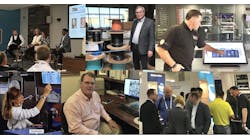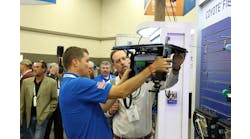Latest from Professional Development/Leadership
Battling the Barrage of Information Coming in Our Direction
Time Management Fundamentals
Every day brings a crushing wave of demands: a barrage of texts, emails, interruptions, meetings, phone calls, tweets, blogs — not to mention the high-pressure demands of our jobs — which can be overwhelming and exhausting. The sheer number of distractions can threaten our ability to think clearly, make good decisions, and accomplish what matters most, leaving one worn out and unfulfilled.
People feel buried in things to do and simultaneously drained of their capacity to do them. They feel agitated and anxious, stressed when they are working and stressed when they are not. It is a semi-permanent state of worried restlessness that pervades our culture and drains us of confidence and joy.
Today it is both easier and harder than ever to achieve extraordinary productivity. To us, this is the heart and soul of today’s time management problem. This fundamental challenge is what we call the "productivity paradox". This paradox will only become more challenging for people who do not know how to tame the paradox and turn it into their advantage.
Figure 1. The 5 Choices Model.
There are 3 critical challenges revolving around this productivity paradox we face shown in Figure 1: Decision Management, Attention Management, and Energy Management.
Challenge 1: Decision Management
We are making more decisions than ever.
The productivity challenge is that the velocity of incoming decisions required to do our work is almost overwhelming. And what most people do — because they are committed, hard-working people — is they try to handle this flow in a linear way. They take decisions as they come, handling them one at a time, making them as well and fast as they can, and then moving on to the next one — like an assembly line.
The problem is that high-value decisions don’t come in a predictable order. They are nonlinear opportunities. If we are not aware, we might miss them entirely, or address them only in a rushed, low-quality way. A linear approach in a non-linear reality is a recipe for failure. Putting our heads down and simply doing more faster does not create extraordinary productivity in a world where value is found in stepping back, prioritizing the choices coming in, and making good decisions on the things that really impact results.
Think about your own work. Doesn’t it feel pretty complex? Are there some areas where the right decisions will make a huge difference in your results? Are you able to devote the time and energy to make these decisions in a quality way?
Challenge 2: Attention Management
Our attention is under unprecedented attack.
While we are trying to handle all the incoming decisions, our attention is under unprecedented attack. All the beeps, buzzes, and banners that invade our mental space come at a cost to our ability to focus on the things that really matter.’
Even your own personal technology can become enemy territory. If you have ever Googled something important and then, 45 minutes of links later, found yourself watching brainless videos or reading things that have no value to you at all, you have experienced how easily your attention can be taken from you if you are not conscious about it.
Bottom line: if we’re not careful, we can go on mental autopilot, moving from one stimulating and distracting input to another, and miss the things that are uniquely meaningful — the things that can make our days, lives, and relationships extraordinary.
Challenge 3: Energy Management
We are suffering from a personal energy crisis.
A productive life is a conscious life, and that takes mental energy. But with today’s technology-enabled unstoppable flow of everything coming at us, we can often feel so worn out and tired that we face our own personal energy crisis. We can’t muster the mental energy to think clearly and, in a knowledge-work world, that is a problem.
As brain researcher John Medina notes, today’s cubicled, sedentary workplaces represent an almost perfect anti-brain working environment.
Everyone has the capability to do extraordinary work. Everyone has the potential to go to bed at the end of the day feeling satisfied and accomplished.
The 5 Choices
The combination of the above factors has a significant impact on how we manage our time and how accomplished or how buried alive we feel on any day, not only at work, but at home and in our community.
Our brain can become wired to react to what feels "urgent", and it actually gives us a dopamine high when we respond to and immediately act on that which seems "important", because it is "urgent". We feel busy and productive in the moment, but then realize at the end of the day that we made decisions to spend time on activities that were not of high value.
The latest brain science shows that we can overcome this "urgency addiction" by rewiring our brain to pause and consider what is actually important. With this strategy, which is referred to as "Pause-Clarify-Decide", we can pause our "Reactive Brain" long enough to use our "Thinking Brain" to clarify everything that is coming at us. Then we can make a conscious and intentional decision as to what is of high value and thus, worth our time and energy. The more we hone this skill, the more we will be able to accomplish the right things and get a better "ROM" — return on every moment in our day.
The secret to feeling and being highly accomplished is to rewire our brain to make intentional, high-value decisions, have very focused attention, and have the sustainable energy to make it all happen. The path to do this is through consciously making the 5 Choices.
Choice 1: Act on the Important, Don’t React to the Urgent.
This choice helps us discern the important from the less and not important, as well as how to increase our Return on the Moment (ROM) in the midst of fierce distractions. In today’s world, we are drowning in email, overwhelmed with demands, and trying to do more with less. With Choice 1, we filter the vitally important priorities from the less and not important so we can focus on what matters most.
Choice 2: Go for Extraordinary, Don’t Settle for Ordinary.
Guide your decision making through a framework of what success looks like in your current, most important roles. Competing priorities often prevent you from achieving extraordinary results. Redefine your current roles in terms of extraordinary results to achieve high-priority goals. Pause, clarify, and decide (PCD) what you will do with every opportunity that comes at you, such as emails that are or are not important. In the midst of fierce distractions use more of your Thinking Brain and less of your Reactive Brain, which will increase your ROM.
Choice 3: Schedule the Big Rocks, Don’t Sort Gravel.
Plan weekly and daily so that you execute with excellence on the most important things. Make the 30/10 Promise; set aside 30 minutes for weekly planning before the week starts and 10 minutes for daily planning before the day starts, so that you spend your valuable time on that which matters most. Create a consistent cadence of planning and execution that produces extraordinary outcomes.
Choice 4: Rule Your Technology, Don’t Let It Rule You.
Make technology work for you, not against you. Turn your technology into a productivity engine. An electronic avalanche of email, texts, and social-media alerts seriously threaten productivity, as never before. Leverage your technology and fend off distractions by optimizing platforms like Microsoft® Outlook®, Google®, and IBM Notes® to boost productivity. Detox your inbox; you must make decisions about each message you receive. Use filters and rules to automate many of the day-to-day emails that take your valuable brain power.
Choice 5: Fuel Your Fire, Don’t Burn Out.
Increase energy so you can think clearly, make good decisions, and feel more accomplished at the end of every day. Today’s exhausting, high-pressure work environment can burn you out. By applying the 5 Energy Drivers™ in Choice 5, you will benefit from the latest in brain science to consistently recharge your mental and physical energy. Start with one of 5 drivers to increase your mental and physical energy — Move.
These 5 Choices, when consistently made, will help individuals personally and professionally feel more accomplished at the end of the day.






